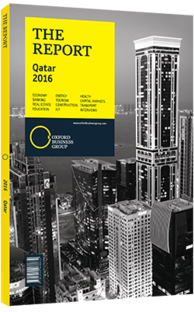A solid performance by Qatar's insurance industry bodes well for future growth
Fueled in large part by government investment in infrastructure and other large-scale construction projects, over the past decade Qatar has become the fastest-growing insurance market in the GCC region, according to recent reports published by ratings firm Moody’s and Dubai-based investment bank Alpen Capital. In 2014 alone Qatari underwriters brought in $2.2bn in gross written premiums (GWPs), which was equal to around 10% of total premiums across the GCC for the year, making Qatar the third-largest insurance market in the region.
The sector’s performance is expected to continue to improve, despite a drop in oil prices that has slowed growth in some other industries. Qatar Insurance Company (QIC), the nation’s largest underwriter, reported 2015 estimated GWP growth of 49%, which suggests a rapid jump across the industry as a whole for the year. “There are certainly challenges,” Mohammed Al Rayes, a technical consultant to the CEO at Qatar Islamic Insurance Company, told OBG in November 2015. “But in general the performance of the sector over the past few years has been very positive, as evidenced by the fast growth of the industry.”
Driving Expansion
Between 2010 and 2014 the market expanded at a compound annual growth rate (CAGR) of 22.4%, according to Alpen. Moody’s cites the increased development of the non-energy sector, rising GDP and the state’s continued focus on infrastructure development in the run-up to Qatar’s turn as host of the 2022 FIFA World Cup as major insurance growth drivers. Moody’s noted that population growth has also contributed to the uptick in insurance uptake. This has contributed to an increase in the compulsory third-party motor segment, which accounts for a significant percentage of many firms’ business, though it is not a particularly profitable line due to the state-set premiums. Additionally, more vehicles on the road has translated into more accidents, which means increased liabilities for insurers. Nonetheless, in general, population growth has positively impacted most local insurers.
The key growth driver in the industry in recent years, however, has been construction activity. In the fourth quarter of 2015 the construction sector expanded 14.8% year-on-year. Between 2015 and 2022 Qatar’s average annual construction growth rate is expected to be 11.4%. Over the course of the following decade (2022-32) the average annual rate is expected to drop only slightly, to 10.2%, according to BMI forecasts. Projects related to the World Cup make up a large component of this activity. That said, a number of other unrelated and semi-related large-scale projects are under way, including the Doha Metro, the continued expansion of the new Hamad Port, three special economic zones, and power and water projects. Covering these projects entails assuming a relatively high amount of risk, much of which is passed on to the reinsurance segment.
Continued Growth
The low insurance penetration level – around 1% in late 2015 – implies “that there is room for significant further growth within the Qatari insurance market,” according to Moody’s. Indeed, most local players and observers expect to see continued growth in insurance activity for years to come. BMI forecasts annual average GWP expansion of around 5% over the period 2015-19, which would bring annual premiums to around $2.49bn by 2019, up from $1.95bn in 2014, for example.
The minister of finance, Ali Shareef Al Emadi, told Qatari daily The Peninsula that the insurance sector had “huge potential”. He expressed the belief that insurance premiums could reach $12bn if the country’s insurance penetration rate could match the global average of 6%. Much of this activity is expected to take place in the non-life segment, and particularly in the key lines of engineering, construction, energy and marine coverage. Additionally, BMI expects motor GWPs to rise by approximately 6.6% annually.
You have reached the limit of premium articles you can view for free.
Choose from the options below to purchase print or digital editions of our Reports. You can also purchase a website subscription giving you unlimited access to all of our Reports online for 12 months.
If you have already purchased this Report or have a website subscription, please login to continue.

